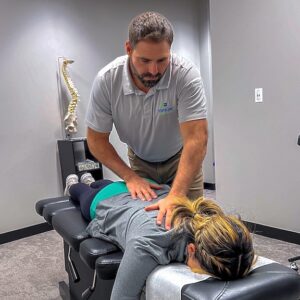Injuries are a part of life, and their recovery often necessitates various forms of care and attention. Among the options available, chiropractic care stands out as a holistic and effective approach to healing. If you’ve ever wondered when the right time is to involve Chiropractic Services in injury recovery, you’re not alone.
Understanding Chiropractic Care
Chiropractic care revolves around the belief that proper alignment of the body’s musculoskeletal structure, especially the spine, enables the body to heal itself without medication or surgery. Chiropractors are trained professionals who specialize in adjusting the spine and other joints to relieve pain, improve function, and support the body’s natural ability to heal.
The Role of Chiropractors in Injury Recovery
1. Pain Management and Relief:
Chiropractors specialize in pain management strategies that go beyond merely masking symptoms. Their focus lies in identifying the underlying causes of pain resulting from injuries. Through hands-on spinal adjustments, manipulations, and various therapeutic techniques, chiropractors aim to alleviate discomfort by addressing the root source of the pain. This natural approach not only provides relief but also facilitates the body’s innate healing process.
2. Root Cause Identification and Correction:
A fundamental aspect of chiropractic care in injury recovery involves identifying and correcting structural misalignments and imbalances in the musculoskeletal system. By conducting thorough assessments and diagnostic evaluations, chiropractors aim to pinpoint the root causes of injuries. These could include spinal misalignments, joint dysfunctions, or soft tissue damage. Through targeted adjustments and personalized treatment plans, chiropractors work towards restoring proper alignment, thereby promoting optimal healing.
3. Restoration of Function and Mobility:
Injuries often lead to limitations in movement and compromised functionality. Chiropractors employ a diverse range of techniques, including spinal adjustments, mobilization, soft tissue therapies, and rehabilitative exercises, to restore range of motion, flexibility, and overall function. By focusing on enhancing mobility, chiropractors aid in accelerating the rehabilitation process, enabling individuals to regain their physical capabilities more effectively.
4. Preventing Chronic Conditions and Complications:
Early intervention by chiropractors can significantly reduce the likelihood of acute injuries progressing into chronic conditions. Timely care and corrective measures implemented by chiropractors aim to prevent the development of long-term complications. Addressing injuries promptly helps mitigate the risk of chronic pain, stiffness, and functional impairments that may arise if injuries are left untreated.
5. Comprehensive Holistic Approach:
Chiropractors adopt a holistic perspective towards injury recovery. They consider not only the injured area but also the interconnectedness of the body’s systems. This comprehensive approach encompasses lifestyle modifications, nutritional guidance, ergonomic advice, and stress management techniques. By addressing the overall health and well-being of patients, chiropractors aim to create an optimal environment for healing.
6. Individualized Treatment Plans:
Chiropractors craft personalized treatment plans tailored to meet the unique needs of each patient. These plans may include a combination of spinal adjustments, therapeutic exercises, soft tissue therapies, and lifestyle recommendations. By customizing treatments based on the specific injury, its severity, and the patient’s overall health, chiropractors ensure that the recovery process is optimized for the individual.
7. Collaboration with Healthcare Professionals:
Chiropractors frequently collaborate with a network of healthcare providers, such as physical therapists, orthopedic specialists, and primary care physicians. This collaboration allows for a synergistic approach to injury recovery, combining expertise from various disciplines to provide comprehensive care that addresses all aspects of the injury.
8. Patient Education and Empowerment:
A key aspect of chiropractic care is educating patients on self-care strategies. Chiropractors empower patients by teaching them exercises, stretches, proper posture, and ergonomic adjustments that can aid in their recovery. Educating patients on proactive self-management techniques ensures that they play an active role in their healing journey and fosters a sense of ownership over their well-being.
9. Long-Term Wellness Guidance:
Beyond the resolution of the immediate injury, chiropractors emphasize the importance of ongoing wellness care. Periodic check-ups, maintenance adjustments, and lifestyle advice are provided to prevent future injuries and maintain optimal musculoskeletal health in the long run.
9. Long-Term Wellness Guidance:
Chiropractors prioritize patient-centered care, taking the time to listen to their concerns, understand their goals, and involve them in decision-making regarding their treatment. This personalized approach fosters a supportive and compassionate environment, ensuring that patients feel heard and valued throughout their recovery process.
Signs That Chiropractic Care Could Help
1. Persistent Pain
Persistent or chronic pain post-injury is a significant indicator that your body might be struggling to recover fully. This kind of pain can result from various factors, such as misaligned vertebrae, strained muscles, or affected joints. Chiropractors specialize in assessing these conditions, identifying the root cause of the pain, and using spinal adjustments to correct misalignments. By addressing the underlying issues, chiropractic care aims to not only alleviate pain but also promote long-term healing without solely relying on medications or invasive procedures.
2. Limited Range of Motion
Injuries often bring about stiffness and reduced flexibility, hindering normal movement. This limitation could be due to muscle strains, inflammation, or structural misalignments resulting from the injury. Chiropractors employ a range of techniques including spinal adjustments, therapeutic exercises, and stretches to restore optimal joint function and flexibility. Through these interventions, chiropractic care aims to enhance mobility and expedite the recovery of full range of motion, thereby aiding in a speedier rehabilitation process.
3. Delayed Healing
A prolonged recovery period or a plateau in the healing process can be a cause for concern following an injury. It might suggest underlying issues that require attention. Chiropractors focus on more than just symptom relief; they aim to optimize the body’s inherent ability to heal. By ensuring proper spinal alignment, chiropractic care Huntley supports improved blood circulation and optimal nerve function, which are crucial for efficient healing. Addressing structural misalignments through chiropractic adjustments may potentially accelerate the body’s healing mechanisms.
4. Recurring or Frequent Injuries
Repeated injuries in the same area might indicate an unresolved underlying problem. Weaknesses or imbalances within the musculoskeletal system could contribute to this recurrence. Chiropractors perform comprehensive assessments to identify these weaknesses and provide targeted treatments to strengthen the affected areas. By addressing these issues at their core, chiropractic care aims to prevent further injuries and improve overall physical resilience.
5. Discomfort Extending Beyond the Injury Site
Injuries can cause a domino effect, resulting in discomfort or pain in seemingly unrelated areas of the body. For instance, an injury to the lower back might prompt compensatory movements that lead to neck strain or headaches. Chiropractors consider the interconnectedness of the body, addressing how one area can impact another due to compensation or misalignment. By restoring overall body balance, chiropractic care aims to alleviate discomfort and facilitate comprehensive healing.
6. Postural Irregularities
Injuries often result in changes to one’s posture due to discomfort or compensatory movements. These alterations can include slouching, uneven shoulders, or a tilted pelvis, causing stress on various parts of the body. Chiropractors specialize in assessing postural problems by examining the spine’s alignment. Through chiropractic adjustments and targeted exercises, they aim to correct spinal misalignments, relieve tension on affected areas, and restore proper posture. By addressing these postural irregularities, chiropractic care aims to not only reduce pain but also prevent future issues associated with poor posture.
7. Nerve-related Symptoms
Injuries may lead to nerve compression or irritation, resulting in sensations like tingling, numbness, or shooting pains. These symptoms often stem from nerve impingement due to misaligned vertebrae or pressure on nerves caused by injured tissues. Chiropractors utilize specialized techniques such as spinal manipulation to alleviate pressure on nerves. By targeting these affected areas, chiropractic care aims to relieve nerve-related symptoms and facilitate the restoration of proper nerve function.
8. Limited Functional Abilities
Following an injury, individuals may experience limitations in their daily activities, such as walking, sitting, or standing for extended periods. These limitations often arise due to musculoskeletal imbalances or compromised joint function caused by the injury. Chiropractors assess these functional limitations and employ specific adjustments and rehabilitative exercises to enhance joint mobility, strengthen supporting muscles, and improve overall functional abilities, thus aiding in a more comprehensive recovery.
9. Headaches or Migraines
Injuries, particularly those affecting the neck or upper back, can contribute to recurring headaches or migraines. These headaches might be triggered by tension in the neck muscles or nerve irritation due to misaligned vertebrae. Chiropractic care targets these headaches by addressing spinal misalignments and reducing tension in the neck and upper back through adjustments and specialized therapies. By focusing on these areas, chiropractors aim to alleviate headaches and migraines, providing relief and promoting overall well-being during the recovery phase.
10. Reduced Athletic Performance
Injuries can significantly impact an athlete’s performance by causing decreased flexibility, weakened strength, or imbalanced movement patterns. These issues often arise due to compromised musculoskeletal function. Chiropractors work closely with athletes to identify and address biomechanical imbalances. Through specific adjustments and tailored exercises, chiropractic care aims to restore optimal musculoskeletal function, enhancing athletic performance, and reducing the risk of future injuries, ensuring athletes can return to their peak levels of performance.
11. Digestive Issues
Surprisingly, certain injuries can indirectly affect digestive health. Misalignments in the spine, especially in the mid-back region, can disrupt nerve function and potentially interfere with signals to the digestive organs. Chiropractors focus on spinal adjustments to restore proper nerve flow, potentially aiding in improved digestion and alleviating associated discomfort. By targeting these spinal misalignments, chiropractic care aims to support better nerve function, potentially contributing to improved digestive health.
12. Sleep Disturbances
Injuries often lead to discomfort that interferes with sleep quality. Persistent pain or discomfort can make it challenging to find a comfortable sleeping position, leading to disrupted sleep patterns. Chiropractors address these issues by alleviating pain through adjustments, promoting relaxation, and improving spinal alignment. By targeting these factors, chiropractic care aims to alleviate discomfort and improve sleep quality, contributing to a more effective healing process.
Finding Chiropractic Services Near You
When seeking Huntley chiropractor services, it’s essential to find a reputable and trustworthy chiropractor in your area. Using online directories or searching “chiropractic near me” can lead you to qualified professionals like Evolve Chiropractic of Huntley, providing tailored care to aid in injury recovery.
Deciding when to involve chiropractic care in injury recovery depends on various factors. From persistent pain to limited mobility, recognizing the signs that indicate the need for chiropractic intervention is crucial. Timing matters, and early engagement with a chiropractor can make a significant difference in the healing process.
10705 Ruth Rd, Huntley, IL 60142, United States
847-802-4866
https://myevolvechiropractor.com/locations/chiropractor-in-huntley-illinois





